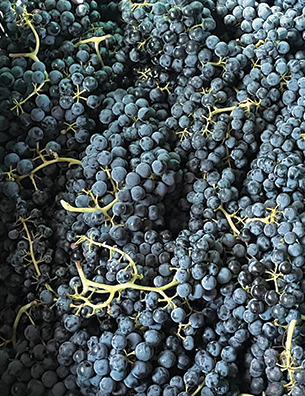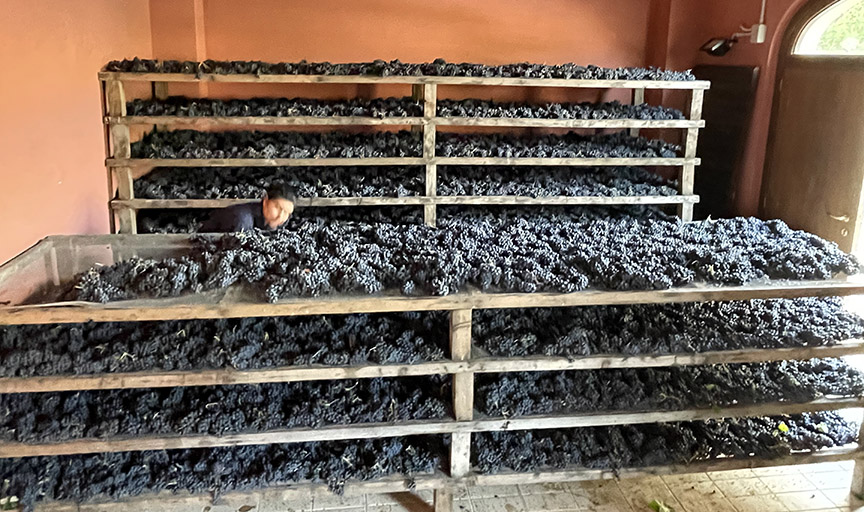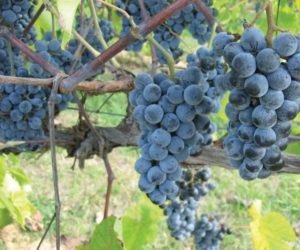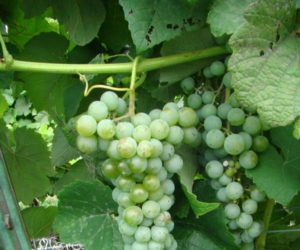
ll around the globe, grape growers and winemakers alike are perpetually in search of the “right” variety. Sometimes, “right” is based on consumer acceptance and not necessarily on the site for which it is grown. But choosing the proper grape variety for the site should always prevail (as I’ve said many times in my tenure writing this column). Soil, topography, temperature, and rainfall are just some of the contributing factors.
In the Old World, centuries of grape cultivation and wine history dictated the variety or varieties found growing in a region. The New World markets and sells many wine varieties on consumer acceptance, but there are those pioneers who step out on a limb and try something different. Sometimes it may just be the pioneer spirit and love for the variety on a previous wine journey, but it is these pioneers that bring alternative varieties to the forefront. Sagrantino is one of those varieties, which is gaining some traction outside of its native Italy, notably in California and Australia.
Sagrantino’s Origins
Italy is surrounded on three sides by the Mediterranean and Adriatic Seas and is home to many wine regions. Umbria, the only landlocked region of the country, is home to Sagrantino. It is grown primarily in and around the village of Montefalco, a small town located about a two-hour drive due north of Rome. Many references refer to Sagrantino as an “indigenous variety.” Defining the term indigenous as it pertains to a grape variety implies that it was originally cultivated in the area.
But, as with many Old World thoughts, Sagrantino vines were slowly being replaced by New World ideas to improve their wines with additions of Cabernet, Merlot, and Syrah. Sagrantino fell from local favor to the point where it was nearly labeled extinct. But it was revived in the early 1970s and in more recent years experienced a 150% increase in vineyard area between 2000 and 2010. While it is hard to determine what the current area is, we know it is gaining in popularity and acreage in both Australia and California.
In most European winemaking regions, there lies a system of quality in place in order not to diminish the reputation of a region. It takes dedication and tenacity of individuals and trade groups to move through the quality certification process. In Italy, the DOC remains the traditional quality system, having basic requirements for quality from the vineyard management and the bottle. With the emergence in the late 1970s, there was established the first DOC of Montefalco Rosso in 1979 and the Sagrantino di Montefalco in 1980. Continued research and practice with the variety led to Sagrantino di Montefalco’s elevation to Denominazione di Origine Controllata e Garantita (DOCG) in 1992. Over 80% of the current production is DOCG, yielding over two million bottles per year. It’s now a rising star, brought out from near extinction.
What is DOCG with respect to Sagrantino? In the Sagrantino di Montefalco, vineyard yields are limited to 8,000 kg/ha (~7,100 lbs./acre) with a wine yield limited to 65% (wine volume-to-pomace weight). The alcohol by volume is limited to 13% for dry reds and 14.5% for the passito wines (more on these later). No blending with other varieties is permitted. Cellar aging before bottling is a minimum of 37 months, with at least 12 months of that in oak barrels. The rules are less strict in Montefalco Rosso, which allows for blending with Sangiovese and other local red varieties, but Sagrantino must comprise 10–25% of the blend.
In the Vineyard
If you are familiar with grapes from this region of Italy, you’ll know Sagrantino likes some heat and sun. Beginning in the vineyard, it’s best to choose a site that will provide a long season of bright sunlight. As a late-ripening variety, it’s best to provide an appropriately opened canopy via leaf removal. Exposing clusters to indirect sunlight allows for tannin development in the berries. Depending on the viticulturalist, the grape takes on a couple of forms of winemaking.
Sagrantino is a red grape, with medium to small clusters consisting of blue-black small grapes, has mid-season budbreak, and flowers in early June. With a long season, it ripens in early- to mid-October. One very notable characteristic is that it contains one of the highest phenolic levels in the grape world (more than even Tannat or Aglianico, and twice that of Cabernet Sauvignon), which plays a major role in the process used when turning it into wine.
In the Winery
As with any grape variety, plug-and-play winemaking cannot always work. Lighter red varieties, like Sangiovese and Pinot Noir, take a lot of finesse in the maceration process to express color and tannin, depending on the clone. But as tannins start increasing in the grape type, actions in the cellar define what is expressed in the wine. Sagrantino is one of the most tannic grape varieties, rough or untimely cellar movements can make a wine overly bitter and excessively astringent.
As previously alluded to, Sagrantino is known for passito wines. The term implies a sweet Italian wine made from dried grapes. Passito is derived from an Italian word that translates to “withering.” This leads to wines higher in alcohol, richer in tannin, and generally sweeter. The style originated in ancient Greece because the resultant wines are more stable for aging. The grapes are harvested at optimal maturity and often brought indoors to dry (although some winemakers choose to sun-dry their grapes). The grapes lose from 10–60% of their moisture after drying from one to six months. The grapes are then crushed and fermented before being moved on to the aging process of the respective DOCG. While the style is made worldwide, Italy produces more passito wines than any other nation. Some other common examples include Amarone and Vin Santo. While the process is possible for home winemakers, the subject matter requires an entire feature article (if you are interested in making a passito wine, I’d recommend starting by reading “Drawing Inspiration from Valpolicella” at www.winemakermag.com/article/drawing-inspiration-from-valpolicella). An easier approach to making Sagrantino wine is following a traditional red grape winemaking process that also applies to many other high-tannin grapes.

The grapes, being small, have a high skin surface-to-juice ratio. This requires careful maceration through the initial crush and destem process. If possible, set the crusher rollers to allow some berries to pass through intact. Allow a cool maceration time of less than 24 hours — just enough time to gather all your chemical data for ameliorations, water for high sugar (greater than 24 °Brix) and acid, if necessary. Inoculate with yeast and allow the fermentation to start, punching down the cap a few times a day as per usual red winemaking protocols. Where the process differs when using a grape variety so high in tannins like this one begins here. Seven days is generally the accepted red wine maceration, but with high-tannin grapes, the longer the grapes remain on the skins during pre-fermentation and fermentation, the more tannin is extracted from both the seeds and skins. Therefore, if the fermenting juice has produced sufficient color, then pressing after five days, while paying close attention to keeping your free-run and press fractions separate, is critical. You can always blend these back together later if desired.
The aging process traditionally involves a barrel. Barrels allow for micro-oxygenation, MOX for short, which helps polymerize the smaller tannin molecules into larger ones that are perceived as less bitter or astringent — hence the minimum aging rules as required by the DOCG. Home winemakers do not have to stare at their carboys for three years though. Mimicking this aging process is possible. Firstly, pay attention the previous step (press cuts). Do not put any more tannin in this wine than you are willing to live with, keeping in mind the press fractions will be even higher in tannins.
Secondly, ensure completion of the malolactic fermentation (MLF). This increase in pH will help with mouthfeel. Follow the MLF with a stabilizing sulfur dioxide addition of about 35 mg/L. Rack the wine as indicated by lees development 2–3 times over 12 months, each time making sure your SO2 is at a minimum of 25 mg/L. Don’t be afraid to introduce a little air into the racking process. As you reach the 12-month mark, to cycle that carboy into your next vintage, tasting the wine and deciding what you have dictates your next move. Still too astringent, but overall are happy with the wine? Bottle it! You want to bottle but don’t like the tannins? Consider backsweetening with grape juice concentrate. Aging the wine longer in a carboy can be risky on a home winemaking scale.
As we progress into the 21st century, we are faced with critical decisions on what makes the right variety in the right site. The science shows world temperatures are warming. Call it what you want, but we will soon be faced with replacing traditional regional varieties. Looking at Sagrantino as a regionally favorable wine, as well as other warmer weather varieties, should start to become commonplace. Resistance to replant hundreds of thousands of vineyard acres will always be there, but the winners will be those who started experimenting early, and Sagrantino is a solid candidate for all grape growers in warmer climates to consider.
Sagrantino Recipe
Yield 5 gallons (19 L)
Ingredients
125 lbs. (57 kg) fresh Sagrantino grapes
Distilled water
10% potassium metabisulfite (KMBS) solution (Weigh 10 grams of KMBS, dissolve into 50 mL of distilled water. When completely dissolved, make up to 100 mL total with distilled water.)
5 g Lallemand D254 yeast
5 g Diammonium phosphate (DAP)
5 g Go-Ferm
5 g Fermaid K (or equivalent yeast nutrient)
Malolactic fermentation starter culture (CHR Hansen or Equivalent)
Equipment
15-gallon (57-L) food-grade plastic bucket for fermentation
5-gallon (19-L) carboy
(1–2) 1-gallon (3.8-L) jugs
Crusher/destemmer
Wine press
Inert gas (nitrogen, argon, or carbon dioxide)
Ability to maintain a fermentation temperature of 81–86 °F (27–32 °C)
Thermometer capable of measuring between 40–110 °F (4–43 °C) in one-degree increments
Pipettes with the ability to add in increments of 1 mL
Step by step
- Clean and sanitize all your winemaking tools, supplies, and equipment.
- Gently crush and destem the grapes. Transfer the must to your fermenter.
- During the transfer, mix in 10 mL of 10% KMBS solution (This addition is the equivalent of 40 ppm SO2).
- Take a sample to test for Brix, acidity, and pH. Keep the results handy. We’ll take this up later.
- Layer the headspace with inert gas and keep covered. Keep in a cool place overnight.
- The next day, sprinkle the Fermaid K directly onto the must and mix well.
- Go back to those lab results you took yesterday. Typical Brix for this style is 24. Typical acid levels will be 0.58–0.62%. Adjust as necessary using tartaric acid. If the acid is higher than 0.7%, don’t panic, this recipe calls for a minimum final acidity of 0.5%. Higher acid won’t hurt here.
- Prepare yeast. Heat ~50 mL distilled water to 108 °F (42 °C). Mix the Go-Ferm into the water to make a suspension. Take the temperature. Pitch the yeast when the suspension is 104 °F (40 °C). Sprinkle the yeast on the surface and gently mix so that no clumps exist. Let sit for 15 minutes. Measure the temperature of the yeast suspension and the temperature of the must. You do not want to add the yeast to your cool juice if the difference in temperature of the yeast and must exceeds 15 °F (8 °C). To avoid temperature shock, acclimate your yeast by taking ~10 mL of the must juice and adding it to the yeast suspension. Wait 15 minutes and measure the temperature again. Do this until you are within the specified temperature range. Do not let the yeast sit in the original water suspension for longer than 20 minutes.
- When the yeast is ready, add it to the fermenter and mix.
- You should see signs of fermentation within one to two days. This will appear as some foaming on the must surface, and it will appear that the berries are rising out of the medium. This is referred to as the “cap rise.”
- You need to have on hand the ability to push the grapes back into the juice to promote color and tannin extraction. This is called “punching down” and this should be done three times per day. Use a clean utensil or your hand to mix.
- Monitor the Brix and temperature twice daily during peak fermentation (10–21 °Brix). Morning and evening are best and more often if the temperature shows signs of exceeding 86 °F (30 °C), in which case place frozen water bottles into the fermentation and mix the must. Wait 15 minutes, mix, and check the temperature again. Repeat as needed to keep the temperature between 81–86 °F (27–30 °C).
- At about 19 °Brix, sprinkle in the DAP and punch down.
- When the Brix reaches 4 (about 4–5 days), transfer the must to your press, and press the cake dry. Keep the free-run wine separate from the press portion for now.
- Transfer the wine to your carboys or 1-gallon (3.8-L) jugs. Your press fraction may only be a gallon or two (up to 8 L). Make sure you do not have any headspace. Place an airlock on the vessel(s) and label them.
- Inoculate with your malolactic bacteria. Check the manufacturer’s instructions on how to prepare and inoculate. Cover the tops with an airlock to allow CO2 to escape.
- Monitor the malolactic fermentation (MLF) using a paper chromatography assay. Follow the instructions included in the kit.
- When MLF is complete, add 2 mL of fresh KMBS (10%) solution per gallon (3.8 L) of wine. This is the equivalent to ~40 ppm addition.
- Measure the pH and titratable acidity. Most importantly you want a finished TA of about 0.60%. The pH is secondary, but should be around 3.6. Add acid to adjust the titratable acidity (TA) prior to settling.
- Place the wine in a cool place to settle.
- After two weeks, test for SO2, adjust as necessary to attain 0.5 ppm molecular SO2. (There is a simple SO2 calculator at winemakermag.com/sulfitecalculator). Check the SO2 in another two weeks and adjust. Once the free SO2 is adjusted, maintain at this level. You’ll just need to check every two months or so, and before racking.
- Rack the wine clean 2–3 times over 12 months to clarify and to assist in softening the tannins. If fining with albumen is needed to reduce astringency, consult the magazine resources for protocols in fining trials. Backsweetening with grape juice concentrate is another way to mitigate tannins, if you like sweeter wines.
- Once the wine is cleared, it is time to move it to the bottle. This would be about 12 months after the completion of fermentation.
- If all has gone well to this point, given the quantity made, it can probably be bottled without filtration. That said, maintain sanitary conditions while bottling. Once bottled, periodically check your work by opening a bottle to enjoy with friends.






